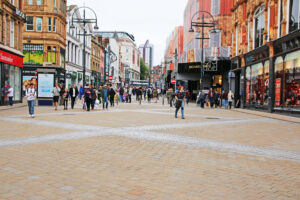As workers return to to the office, they also return to city centre shops


The return of the office commute helped to bring people back to high streets and town centres last month, but shopper numbers remain stubbornly below pre-pandemic levels, new figures show.
The number of people going to shops was up 10.4 per cent last month, compared with February last year, but is 8.8 per cent down on 2019 levels, according to the latest BRC-Sensormatic IQmonitor.
The recovery was sharpest in traditional high streets and shopping centres, up by 17.8 per cent and 11.7 per cent, respectively, and driven by the return of commuters to offices.
This was balanced by a decline in the use of out-of-town retail parks. Seen as safer alternatives to busy high streets during the pandemic, they experienced a 3.3 per cent decline in numbers last month.
Cold weather, the high cost of living and a looming rise in household energy bills contributed to keeping shoppers away.
Helen Dickinson, chief executive of the British Retail Consortium, said: “Growth in footfall slowed this month after the rush of Christmas shopping and January sales. Some people are making fewer visits as the cost of living continues to bear down ahead of the April energy price rise.” She said retailers were investing in their “store experience” but consumer confidence was weak and it was “vital” that the government did not burden the retail industry with extra regulatory costs that hinder investment.
Richard Lim, a retail analyst, said the data showed workers were being “encouraged to get back into the office at least two or three times a week”.
A central London “back to the office” benchmark by Springboard found last month that footfall activity at office hotspots had risen as workers returned to offices.
UK consumer confidence rebounded in February to its highest level in almost a year, although GfK, the research group, said it was “still severely depressed”.
Read more:
As workers return to to the office, they also return to city centre shops
